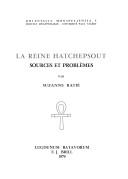| Listing 1 - 8 of 8 |
Sort by
|
Book
ISBN: 9782756406770 2756406775 Year: 2013 Publisher: Paris : Pygmalion,
Abstract | Keywords | Export | Availability | Bookmark
 Loading...
Loading...Choose an application
- Reference Manager
- EndNote
- RefWorks (Direct export to RefWorks)
En trois millénaires, l'Egypte pharaonique n'a été gouvernée que quatre fois par une reine ayant officiellement adopté les attributs d'un monarque à part entière. Mais bien plus nombreuses furent celles qui, régentes pendant la minorité d'un roi, dirigèrent de ce fait l'Etat, parfois pendant plus d'une dizaine d'années. D'autres encore eurent une influence de tout premier plan à travers leur époux, et s'investirent dans les affaires du pays en jouant à ses côtés un rôle à la fois politique et religieux. Cet ouvrage rassemble douze portraits de reines dont les traits nous ont été transmis par de nombreux monuments. Les plus célèbres - Hatchepsout, Tiyi, Néfertiti, Néfertari - en côtoient de moins connues, mais toutes ont marqué leur temps, qu'elles aient par leur présence garanti la continuité de l'Etat, ou, au contraire, menacé sa stabilité par des intrigues de cour. En relatant ces douze destins hors du commun, Pierre Tallet nous fait revivre de grands moments de l'histoire égyptienne, de ses origines à la fin du Nouvel Empire.
Reines --- Égypte --- Civilisation --- Queens --- Queens - Egypt - Biography
Book
ISBN: 1649031688 9781649031686 Year: 2020 Publisher: La Vergne The American University in Cairo Press
Abstract | Keywords | Export | Availability | Bookmark
 Loading...
Loading...Choose an application
- Reference Manager
- EndNote
- RefWorks (Direct export to RefWorks)
"During the last half of the fourteenth century BC, Egypt was perhaps at the height of its prosperity. It was against this background that the "Amarna Revolution" occurred. Throughout, its instigator, King Akhenaten, had at his side his Great Wife, Nefertiti. When a painted bust of the queen found at Amarna in 1912 was first revealed to the public in the 1920s, it soon became one of the great artistic icons of the world. Nefertitis name and face are perhaps the best known of any royal woman of ancient Egypt and one of the best recognized figures of antiquity, but her image has come in many ways to overshadow the woman herself. Nefertitis current world dominion as a cultural and artistic icon presents an interesting contrast with the way in which she was actively written out of history soon after her own death. This book explores what we can reconstruct of the life of the queen, tracing the way in which she and her image emerged in the wake of the first tentative decipherment of Egyptian hieroglyphs during the 1820s-1840s, and then took on the world over the next century and beyond. All indications are that her final fate was a tragic one, but although every effort was made to wipe out Nefertitis memory after her death, modern archaeology has rescued the queen-pharaoh from obscurity and set her on the road to todays international status."--Publishers description.
Book
ISBN: 9780307956767 9780307956781 0307956768 Year: 2014 Publisher: New York : Crown,
Abstract | Keywords | Export | Availability | Bookmark
 Loading...
Loading...Choose an application
- Reference Manager
- EndNote
- RefWorks (Direct export to RefWorks)
Hatshepsut—the daughter of a general who usurped Egypt’s throne and a mother with ties to the previous dynasty—was born into a privileged position in the royal household, and she was expected to bear the sons who would legitimize the reign of her father’s family. Her failure to produce a male heir was ultimately the twist of fate that paved the way for her improbable rule as a cross-dressing king. At just over twenty, Hatshepsut ascended to the rank of pharaoh in an elaborate coronation ceremony that set the tone for her spectacular reign as co-regent with Thutmose III, the infant king whose mother Hatshepsut out-maneuvered for a seat on the throne. Hatshepsut was a master strategist, cloaking her political power plays in the veil of piety and sexual reinvention. Just as women today face obstacles from a society that equates authority with masculinity, Hatshepsut shrewdly operated the levers of power to emerge as Egypt’s second female pharaoh. Hatshepsut successfully negotiated a path from the royal nursery to the very pinnacle of authority, and her reign saw one of Ancient Egypt’s most prolific building periods. Scholars have long speculated as to why her monuments were destroyed within a few decades of her death, all but erasing evidence of her unprecedented rule. Constructing a rich narrative history using the artifacts that remain, noted Egyptologist Kara Cooney offers a remarkable interpretation of how Hatshepsut rapidly but methodically consolidated power—and why she fell from public favor just as quickly. The Woman Who Would Be King traces the unconventional life of an almost-forgotten pharaoh and explores our complicated reactions to women in power.
Hatshepsut --- Queens --- Pharaohs --- Hatshepsut, --- Egypt --- History --- Kings and rulers --- Queens - Egypt - Biography --- Pharaohs - Biography --- Hatshepsut, - Queen of Egypt --- Egypt - History - Eighteenth dynasty, ca. 1570-1320 B.C. --- Egypt - Kings and rulers - Biography
Book
ISBN: 9782340002227 2340002222 Year: 2014 Publisher: Paris : Ellipses,
Abstract | Keywords | Export | Availability | Bookmark
 Loading...
Loading...Choose an application
- Reference Manager
- EndNote
- RefWorks (Direct export to RefWorks)
Biographie de Bérénice II, princesse libyenne devenue reine d'Egypte après son mariage avec Ptolémée Evergète, troisième roi de la dynastie lagide, qui régna sur l'Egypte grecque
Queens --- Reines --- Biography --- Biographies --- Berenice, --- Egypt --- Egypte --- History --- Histoire --- Queens - Egypt - Biography --- Berenice, - Queen, consort of Ptolemy III, King of Egypt, - approximately 270 B.C.-221 B.C. --- Egypt - History - 332-30 B.C.
Book
ISBN: 271441057X 271442032X 9782714410573 Year: 1976 Publisher: Paris : P. Belfond,
Abstract | Keywords | Export | Availability | Bookmark
 Loading...
Loading...Choose an application
- Reference Manager
- EndNote
- RefWorks (Direct export to RefWorks)
Queens --- Biography --- Nefertiti, --- Egypt --- History --- Antiquities --- Néfertiti, reine d'Egypte, 14e s. av. J.-C. --- Égypte --- Antiquités. --- Antiquities. --- Queens - Egypt - Biography --- Nefertiti, - Queen of Egypt, - active 14th century B.C. --- Egypt - History - To 332 B.C. --- Egypt - Antiquities
Book
ISBN: 9780195370898 0195370899 9780195370881 0195370880 0199707960 1299950779 9780199707966 9781299950771 Year: 2014 Publisher: Oxford : Oxford University Press,
Abstract | Keywords | Export | Availability | Bookmark
 Loading...
Loading...Choose an application
- Reference Manager
- EndNote
- RefWorks (Direct export to RefWorks)
Queens --- Reines --- Biography. --- Biographies --- Berenice, --- In literature --- Egypt --- Egypte --- History --- Histoire --- Bérénice II (reine d'Egypte ; 0270?-0221 av. J.-C.) --- In literature. --- Bérénice --- Queens - Egypt - Biography --- Berenice, - Queen, consort of Ptolemy III, King of Egypt, - approximately 270 B.C.-221 B.C. --- Berenice, - Queen, consort of Ptolemy III, King of Egypt, - approximately 270 B.C.-221 B.C. - In literature --- Egypt - History - 332-30 B.C.

ISBN: 9004060642 9789004060647 Year: 1979 Volume: 1 Publisher: Leiden : Brill,
Abstract | Keywords | Export | Availability | Bookmark
 Loading...
Loading...Choose an application
- Reference Manager
- EndNote
- RefWorks (Direct export to RefWorks)
Queens --- Biography --- Hatshepsut, --- Egypt --- History --- -Royalty --- Rulers --- Sovereigns --- Monarchy --- Women --- Courts and courtiers --- Empresses --- Kings and rulers --- Hatshepsut Queen of Egypt --- -Queens --- -Biography. --- Biography. --- -Biography --- Hatchepsout, --- Hâtshopsîtû, --- Hatschepsut, --- Hatasu, --- Hatshepsout, --- Hatchepsut, --- Queens - Egypt - Biography --- Hatshepsut, - Queen of Egypt --- Egypt - History - Eighteenth dynasty, ca. 1570-1320 B.C. --- Hatshepsout (reine d'Égypte ; 1550-1484 av. J.-C.) --- Égypte --- Rois et souverains --- Reines et impératrices --- Antiquité --- Biographies

ISBN: 0802043135 9786612028427 1282028421 1442676000 9781442676008 9780802043139 Year: 2000 Volume: 37 37 Publisher: Toronto Buffalo London : University of Toronto Press,
Abstract | Keywords | Export | Availability | Bookmark
 Loading...
Loading...Choose an application
- Reference Manager
- EndNote
- RefWorks (Direct export to RefWorks)
"Scholars have long known that the Ptolemaic monarchy of Egypt underwent a transformation between 323 and 30 B.C. The queens of that dynasty started as subordinates of the kings but ended as their superiors. Exactly when and how this change occurred has proven problematic for modern scholars. R.A. Hazzard argues that this change was put in motion by Ptolemy II, who glorified his sister Arsinoe and made acceptable a civilian style of kingship based on piety towards his real and mythical ancestors. Ptolemy's support and elevation of his sister inspired the queens of the line to assert themselves at the expense of their male associates. The process culminated in the absolute rule of Kleopatra VII after 47 B.C." "Hazzard presents a clear argument based on the numismatic, epigraphical, papyrological, literary, and historical sources."--Jacket.
Monarchy --- -Propaganda, Egyptian --- Queens --- -Egyptian propaganda --- Royalty --- Rulers --- Sovereigns --- Women --- Courts and courtiers --- Empresses --- Kings and rulers --- Kingdom (Monarchy) --- Executive power --- Political science --- Royalists --- History --- Biography --- Ptolemaic dynasty --- Egypt --- -Monarchy --- Egypte --- Ägypten --- Egitto --- Egipet --- Egiptos --- Miṣr --- Southern Region (United Arab Republic) --- Egyptian Region (United Arab Republic) --- Iqlīm al-Janūbī (United Arab Republic) --- Egyptian Territory (United Arab Republic) --- Egipat --- Arab Republic of Egypt --- A.R.E. --- ARE (Arab Republic of Egypt) --- Jumhūrīyat Miṣr al-ʻArabīyah --- Mitsrayim --- Egipt --- Ijiptʻŭ --- Misri --- Ancient Egypt --- Gouvernement royal égyptien --- -Propaganda, Egyptian. --- Propaganda, Egyptian. --- Egyptian propaganda --- Ptolemaic dynasty, --- History. --- Propaganda, Egyptian --- Biography. --- 332-30 B.C. --- Ptolemaic dynasty, - 305-30 B.C. --- Monarchy - Egypt - History. --- Queens - Egypt - History. --- Queens - Egypt - Biography.
| Listing 1 - 8 of 8 |
Sort by
|

 Search
Search Feedback
Feedback About
About Help
Help News
News